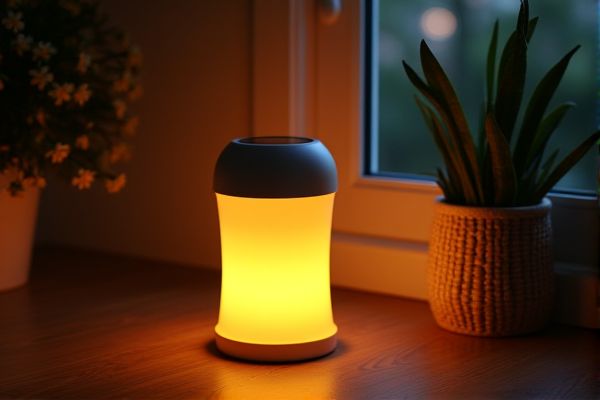
Solar powered lamps harness sunlight to provide eco-friendly, cost-effective lighting without the need for frequent battery replacements, making them ideal for outdoor use and sustainability. If you want to discover the best option for your lighting needs, read on to explore the advantages and drawbacks of both solar powered and battery operated lamps.
Table of Comparison
| Feature | Solar Powered Lamp | Battery Operated Lamp |
|---|---|---|
| Power Source | Solar energy via built-in solar panel | Replaceable/rechargeable batteries |
| Energy Efficiency | High; uses renewable solar energy | Depends on battery type; limited by battery capacity |
| Operating Cost | Low; no electricity or battery replacement cost | Moderate to high; battery replacements or charging costs |
| Environmental Impact | Eco-friendly; reduces carbon footprint | Potential waste from used batteries |
| Portability | High; no wires needed and rechargeable in sunlight | High; lightweight and easy to carry |
| Usage Dependency | Requires sunlight for charging | Usable anytime, independent of sunlight |
| Runtime | Limited by solar charge and battery capacity | Consistent until battery drains |
| Maintenance | Minimal; clean solar panel periodically | Battery replacement or recharging required |
| Cost | Initial cost higher, long-term savings | Lower initial cost, higher long-term expenses |
Introduction to Solar and Battery Operated Lamps
Solar-powered lamps harness energy from sunlight through photovoltaic cells, converting it into electricity stored in internal rechargeable batteries, providing an eco-friendly and cost-efficient lighting solution. Battery-operated lamps rely on disposable or rechargeable batteries as their main power source, offering portability and consistent light output but often resulting in higher long-term costs and environmental waste. The choice between solar and battery lamps depends on factors like usage environment, energy sustainability, and maintenance preferences.
How Solar Powered Lamps Work
Solar powered lamps use photovoltaic cells to convert sunlight into electrical energy, which charges an internal rechargeable battery during the day. The stored energy powers LED bulbs at night, providing illumination without the need for external electricity sources. This eco-friendly system reduces energy costs and lowers carbon emissions compared to traditional battery-operated lamps relying on disposable or replaceable batteries.
How Battery Operated Lamps Function
Battery operated lamps function by storing electrical energy in rechargeable or disposable batteries, which supply power to the lamp's LED or incandescent bulb when switched on. These lamps rely entirely on the battery's charge, requiring periodic replacement or recharging to maintain illumination. Unlike solar powered lamps that harness sunlight for energy, battery operated lamps offer consistent light output regardless of weather or time but depend heavily on battery life and availability.
Energy Efficiency Comparison
Solar powered lamps convert sunlight into electricity using photovoltaic cells, offering sustainable energy with zero fuel costs and minimal environmental impact. Battery operated lamps rely on chemical energy stored in batteries, which require regular recharging or replacement, leading to ongoing energy consumption and waste. Solar lamps typically achieve higher energy efficiency by harnessing renewable sunlight directly, reducing dependency on grid electricity and fossil fuels compared to battery powered alternatives.
Cost Analysis: Initial and Long-Term Expenses
Solar-powered lamps have higher initial costs due to solar panels and rechargeable batteries, but lower long-term expenses because they harness free solar energy and require minimal electricity. Battery-operated lamps typically have lower upfront prices but incur continuous costs from purchasing disposable batteries or frequent recharging, increasing overall expenses over time. Evaluating total cost of ownership favors solar-powered lamps for users seeking sustainable and economical lighting solutions.
Environmental Impact Assessment
Solar powered lamps significantly reduce carbon emissions by harnessing renewable energy, minimizing reliance on fossil fuels and decreasing hazardous waste linked to battery disposal. Battery operated lamps contribute to environmental pollution through the extraction of raw materials like lithium and cobalt, and improper disposal poses risks of soil and water contamination. Lifecycle analyses reveal that solar lamps offer a more sustainable solution by providing long-term energy efficiency and reducing the ecological footprint compared to conventional battery-powered alternatives.
Portability and Convenience
Solar powered lamps offer high portability by eliminating the need for frequent battery replacements and allowing easy recharging through sunlight, making them ideal for outdoor use and remote areas. Battery operated lamps provide convenience with consistent light output regardless of weather conditions but require carrying spare batteries and can be less environmentally friendly. Both types deliver portability, yet solar lamps excel in sustainable convenience while battery lamps shine in reliability during prolonged indoor or emergency use.
Brightness and Performance Differences
Solar powered lamps rely on sunlight to charge their batteries, providing bright illumination during the night but performance can vary based on weather and solar panel efficiency. Battery operated lamps deliver consistent brightness regardless of environmental conditions, with performance depending on battery type and capacity. Your choice between the two should consider the need for reliable light output versus eco-friendly and cost-saving features.
Maintenance and Lifespan
Solar-powered lamps require minimal maintenance, mainly involving occasional cleaning of solar panels to ensure efficient energy absorption, whereas battery-operated lamps need regular battery replacements that can be costly and environmentally unfriendly. The lifespan of solar-powered lamps typically extends beyond 5-7 years due to durable LED components and rechargeable lithium-ion batteries, while battery-operated lamps often last 2-3 years depending on the battery quality and frequency of use. Efficient energy management in solar lamps reduces performance degradation over time, offering a longer-lasting and eco-friendly lighting solution compared to conventional battery-operated counterparts.
Best Use Cases for Each Lamp Type
Solar powered lamps excel in outdoor settings where access to electricity is limited, making them ideal for garden lighting, camping trips, and emergency situations. Battery operated lamps provide reliable, portable illumination suitable for indoor use, power outages, and activities requiring consistent brightness over extended periods. Choosing the right lamp depends on your need for eco-friendly energy sources versus dependable, long-lasting power availability.
 homyna.com
homyna.com